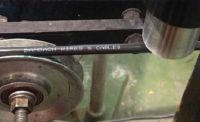Industrial, commercial and residential builders have relied on Uponor Inc.’s cross-linked polyethylene (PEX) pipe for more than 30 years. Besides plumbing, this plastic pipe is used for radiant heating and cooling, fire-sprinkler and infrastructure systems.
A code is printed on each section of pipe for traceability. The code must meet requirements set forth by the American National Standards Institute (ANSI) and the European Union (EU).
At its headquarters plant in Apple Valley, MN, Uponor produces thousands of feet of PEX piping every day for four product lines: AquaPEX (plumbing), AquaSAFE (sprinklers), Wirsbo hePEX (radiant systems) and Ecoflex (pre-insulated pipe systems).
For the last few years, printing high-quality, long-lasting codes has been a challenge. Some of Uponor’s printers couldn’t meet ANSI and EU text requirements, or they featured bottles that didn’t fully empty, resulting in wasted ink through spills or dried residue. In addition, certain inks were not able to withstand extreme temperatures and adhere to pipe throughout its life.
All of these problems increased the company’s printing costs and often caused production shutdowns. They also led Uponor to replace its printing equipment early in 2013 with several 1610 dual head and 1620 continuous inkjet printers made by Videojet Technologies Inc.
Brian Czapiga, electrical control engineering supervisor at Uponor, says the company selected these printers because of their flexibility. Specifically, the printers handle a larger variety of inks, and they cleanly print a wide range of graphics, symbols and trademarks. This enables Uponor operators to set up new jobs quickly, without any errors, and to print high-quality codes on pipe with secondary coatings.
“Before, we had to have a graphic set burned, but now we can create our own graphics and just send them to the printers,” explains Czapiga. “This flexibility is a big win for us. We can print graphics on the fly or easily create [them] from scratch—saving us precious time and money.”
He says the printers’ high speed and efficiency have increased manufacturing yield by 5 percent. Equally important, these capabilities enable Uponor to mark pipe with only one-third as many printers as before.
The company also has seen a 90 percent reduction in waste associated with printing errors and a 40 percent savings in ink and make-up costs. Czapiga says this is due to the printers’ self-contained cartridge, which is designed to eliminate fluid spills and ensure that all fluids drain from the cartridge before replacement. Ink change-outs are quick and mess-free. Another reason is the dual unit’s printhead, which automatically calibrates itself.
Czapiga says the printers are designed to easily integrate into production lines and require very little maintenance. As a result, Uponor achieved ROI in just a few months.
“We originally planned to dedicate two [workers] to servicing the printers, but they’re fairly self-sufficient,” says Bryan Baxter, process engineer at Uponor. “Now, those employees work elsewhere on the lines.”
Citing improved equipment efficiency, the Manufacturers Alliance association of Minnesota named Uponor its 2013 Manufacturer of the Year. For more information about inkjet printers, call 870-242-1759 or visit www.videojet.com.




